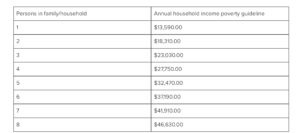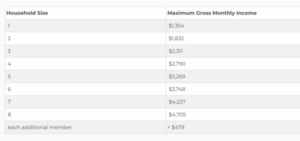According to the Institute for Women’s Policy Research, one in eight single moms is unemployed.
If you’re currently out of work and struggling, the government can provide financial assistance and essential items for you and your children. These programs are being cited as a great success in reducing child poverty by 59% over the past three decades, including helping many single moms work.
How a single mom can get government money through welfare programs
We put together a list of government help for single mothers with no income. For each of these reputable government welfare programs, we’ve broken down the qualifications to receive assistance and provided links to apply.
What is welfare, and what kinds of welfare programs are there in the U.S.?
Welfare programs in the United States are defined as government programs paid to the poor. Recipients of these government entitlements are typically people who work, but earn below a certain amount.
There are dozens of federal and state welfare programs, that include help with food, rent and housing, medical and health care, child care, preschool, and financing college.
Cash assistance programs
TANF
TANF, or Temporary Assistance for Needy Families, is the new name for cash assistance once called ‘welfare.’ Today the program requires participants to work part-time or prove that they’re looking for work. There is a federal maximum of 60 months you can receive TANF benefits, though each state creates its own limits.
How TANF works
TANF payments are automatically loaded onto an Electronic Benefit Transfer (EBT) card which is used like a debit card to pay for limited expenses, including rent, daycare, and food.
To qualify for TANF, you must:
- Have children
- Be pregnant
- Be under age of 18 and the head of your household
- Have low income — as defined by your state
TANF is administered through your state’s welfare services, which may be called Department of Human Services, Department for Children and Families, Economic Services Division, Workforce Services, Department of Social Services or related names. Recognized tribes also administer their own TANF programs.
Each state’s TANF qualifications, rules and payments are different, but can include:
- Income
- Assets
- Number of household members
- Number of children under age 18
- How long you have already received TANF benefits. All states except for Massachusetts and New York have limits
Here are the four purposes of TANF:
- Provide assistance to needy families so that children can be cared for in their own homes or in the homes of relatives
- End the dependence of needy parents on government benefits by promoting job preparation, work, and marriage
- Prevent and reduce the incidence of out-of-wedlock pregnancies
- Encourage the formation and maintenance of two-parent families.
This pro-two-parent-family agenda is reflected in child support laws, which require that a man’s child support checks go to repay TANF outlays to their families.

For families/households with more than eight people, add $4,720.00 for each additional person.
TANF work requirements
To continue receiving TANF benefits, you must participate in work activities for an average of 30 hours per week or get a job within two years of first receiving benefits.
Single parents must participate in a work activity for a minimum of 20 hours per week if your child is under age 6, or 30 hours if the kid is over age 6.
Work activities can include paid and unpaid work, training, vocational school, community service, or provide child care for others completing community service.
Some states deny extra TANF funds to families with more children, the “family cap” designed to disincentivize poor women from having more children.
These states still have family caps:
- Arizona
- Arkansas
- Connecticut
- Delaware
- Florida
- Georgia
- Indiana
- Mississippi
- North Carolina
- North Dakota
- South Carolina
- Tennessee
- Virginia
Most states require you not have more than $2,000 in cash assets, though Alabama, Colorado, Louisiana, Maryland, Ohio, and Virginia have done away with those limits..
Learn more about TANF and where to find government help for families nearby.
Guaranteed income (or universal basic income)
Universal Basic Income, or UBI, is increasingly gaining popularity as an efficient, effective way to alleviate poverty and improve society overall. The essence of these programs is that by giving people a guaranteed sum of cash each month — opposed to expensive, cumbersome and inefficient programs — recipients are more likely to get the services or resources they need, money flows more freely in local economies, and society overall benefits from a sense that we take care of one another, studies are finding.
Single moms stand to benefit the most from this kind of aide. From feminist news site The 19th:
About 56 percent of the people who live in poverty in the United States are women, and most of those are women of color. Of that group, unmarried women with children, like Nichols, are the most likely to be below the federal poverty line. For her family of five, that’s $30,680.
Here is a list of pilot UBI programs:
Mayors for Guaranteed Income
A coalition of 36 mayors from places like Atlanta, Pittsburgh, Philadelphia, Los Angeles, New Orleans, Compton and Stockton, Calif., Gainesville, Fla., Wausau, Wisc., and Jackson, Miss., came together to test UBI programs in their cities. Twitter CEO Jack Dorsey committed $15 million to the organization.
Magnolia Mother’s Trust
Magnolia Mother’s Trust is a pilot program founded in 2018 that provides $1,000 a month for a year to low-income Black mothers living in affordable housing in Jackson, Miss. The program started with 20 recipients and now serves 100 mothers annually, who also get $1,000 in a 529 college savings account for their children.
Los Angeles Economic Assistance Pilot
The city of Los Angeles is launching what it calls “the largest guaranteed income economic assistance pilot program in our nation’s history.” The city will select 3,000 families living in poverty to receive $1,000 a month for a year, with no rules for how the money is spent. Applicants must have at least one dependent minor or be pregnant, in addition to experiencing financial or medical hardships as a result of the COVID-19 pandemic.
Jain Family Institute
Since 2016, Jain Family Institute has built a global network of fellows, advisors, and partners that provides a unique view into the variety of ways cash transfer programs can be structured and implemented. Their whitepapers cover disbursement infrastructure, interactions with existing benefits, and optimal guaranteed income design.
Oakland Resilient Families
The Oakland, Calf., city program, which has raised $6.75 million from private donors, will give low-income families of color $500 per month.
Food assistance programs
Find a food pantry near you using Food Finder, which will connect you with free food given away through local churches, community programs, charities in all 50 states.
Find your local food bank through the Feeding America website.
USDA National Hunger Hotline: 1-866-3-HUNGRY (1-866-348-6479) or 1-877-8-HAMBRE (1-877-842-6273). Monday through Friday, 7:00 AM to 10:00 PM Eastern.
Government food assistance programs including SNAP / food stamps / WIC are enhanced during the pandemic.
Do you qualify for food stamps? Each state has its own income limits. Check with your local agencyto see if you qualify. As one example, here is the current income limit chart for Pennsylvania:

See if your local schools offer free meals for families with children, and food programs for senior citizens.
WIC
The Women Infants and Children program for families with children aged 5 and younger offers food coupons you can use at grocery stores, markets and bodegas, for qualifying food. Learn whether you are eligible for WIC, and how to apply.
SNAP
The Supplemental Nutrition Assistance Program loads financial credit to low-income people on a debit card, that you use at your local grocery store and market. Learn how to qualify, and apply online for SNAP.
During the pandemic, the Biden administration expanded benefits for SNAP recipients through Sept. 30, 2021. Many states have chosen to continue those benefits indefinitely into 2022:
- Alabama
- Georgia
- Hawaii
- Illinois
- Iowa
- Kentucky
- Maine
- Maryland
- Michigan
- New Jersey
- North Carolina
- Ohio
- Oklahoma
- Oregon
- Pennsylvania
- Rhode Island
- South Carolina
- Virginia
- Washington
- West Virginia
- Wisconsin
- Wyoming
School Breakfast and Lunch Programs
The national school breakfast and lunch program helps families with food through their local schools and daycare centers by providing free breakfasts and lunches to students.
As of April, 2021, SNAP emergency funding was expanded by an additional $1 billion per month to 25 million people as part of the Biden-Harris Administration’s American Rescue Plan Act, which includes:
- Extending a 15 percent increase in SNAP benefits— providing over $1.1 billion per month in additional benefits through September 2021;
- Funding meals for young adults experiencing homelessness through Child and Adult Care Food Program emergency shelters;
- Providing nearly $900 million for the Special Supplemental Nutrition Program for Women, Infants and Children, including a temporary increase in fruit and vegetable vouchers to $35 per month
Special Milk Program
If your school does not have a free breakfast or lunch program, they may qualify for the special milk program.
Summer Food Service Program
The federal Summer Food Service programs helps families who depend on school lunches and breakfasts to access nutritious foods during summer breaks.
For more, read our guides on free food and free formula.
Housing assistance programs
Even if you have a solid income, you may qualify for first-time homeowners programs, or rental assistance.
Read more about housing help in this post about free housing and rental assistance — plus home loans and first-time home-buyer programs.
Low Income Home Energy Assistance Program (LIHEAP)
Low Income Home Energy Assistance Program (LIHEAP) helps low-income families and individuals with energy costs, energy crisis hellp, weatherization and energy-related home repairs. Find info for your state here.
Child care assistance programs
Public assistance day care programs
Each state’s Health and Human Services can help you find grants and money for low-cost or free daycare, based on your need, income and program availability in your area. Learn about your options at the Office of Childcare Website.
Head Start daycare
Head Start and Early Head Start is an established federal program that has proven successful in providing educational readiness for low-income children under age 5 from low-income families. The program’s goals are to help all children get ready for school, as well as provide affordable child care to their parents.
Find Head Start programs near you.
State child care assistance subsidies for single moms
Each state has child care assistance programs that can help you find quality day care centers, and pay for them. Find programs in your state and town with the Office of Child Care’s website.
Also, rea the guide on free and affordable child care asstiance programs you — as well as free preschool and free after-school.
There are many more government programs that can help with free medical care, including:
Free and low-cost prescriptions
Article by Wealthysinglemommy.com founder Emma Johnson
